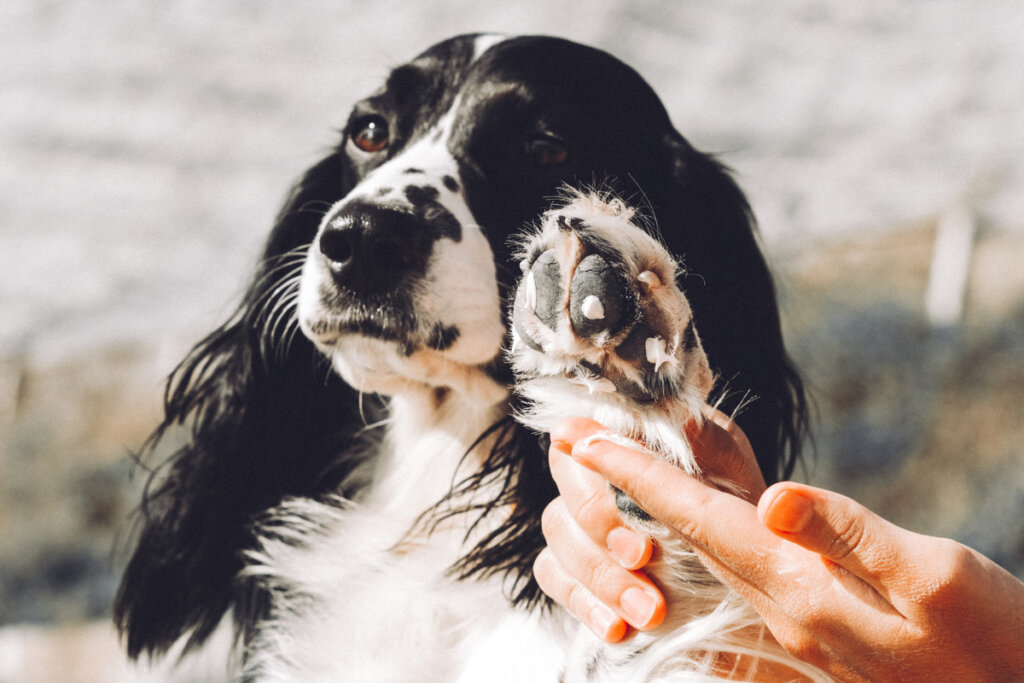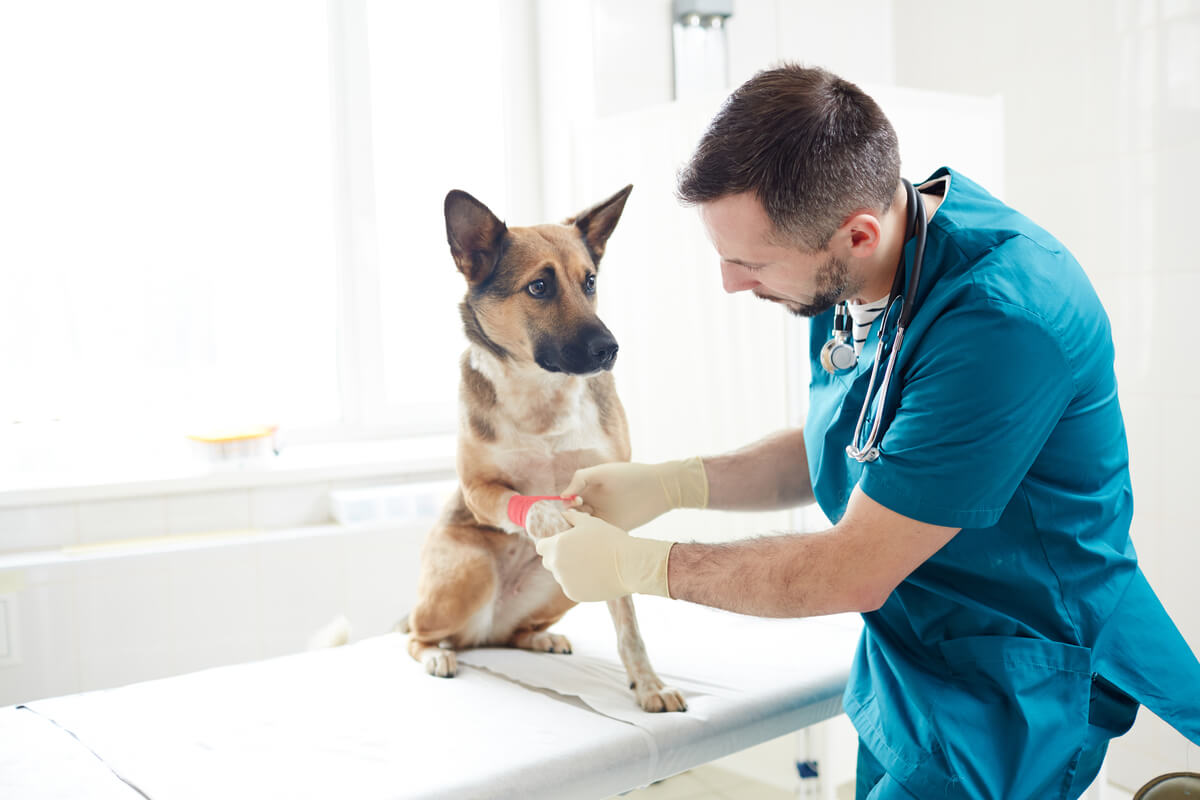Blastoestimulina for Dogs: Uses and Contraindications

Blastoestimulina ointment is a fairly common drug in homes, as it doesn’t require a prescription to obtain it and is used in human medicine. However, the use of blastoestimulina for dogs is also possible.
The function of this ointment in dogs is the same as in people, but its proper use and possible contraindications must be considered before applying it to the animal. As always, before the administration or application of any drug in pets, the authorization and indication of the veterinarian will always be necessary.
What is blastoestimulina?
Blastoestimulin is an ointment that’s used in dogs due to its antibiotic and healing effect. We emphasize the fact that the most suitable format for dogs is an ointment, as blastoestimulina exists in other types of formats in human medicine.
For example, blastoestimulina can be found as a skin powder, as a spray, or in the form of vaginal ovules. These presentations have a different composition than that of the ointment, so its safe use in dogs from home is not advisable. Let’s see what these components are.

Components of blastoestimulina for dogs
Blastoestimulina ointment is composed of the following elements:
- Neomycin sulfate: Neomycin is a very effective antibiotic against many bacteria, so its use is broad spectrum.
- Gotu kola extract: This element works as a protector against wounds, in addition to promoting and accelerating the healing process. As a result, it reduces possible inflammation. On the other hand, it also has an antimicrobial effect.
- Excipients: The elements that give the drug its shape and texture are corn oil, geranium oil, diethylene glycol monostearate, lavender essence, and purified water.
As mentioned above, the other formats used in human medicine don’t have the same ingredients, which is why they aren’t administered in dogs. For example, the skin powder only contains gotu kola, while the spray doesn’t use neomycin, but does use an anesthetic.
Uses of blastoestimulina for dogs
The truth is that, as it’s a drug primarily formulated for human use, it may not be the first option for dogs. It’s common for vets to opt for other drugs with similar (or the same) components, but made exclusively to be used in veterinary medicine.
Even so, the specific use of blastoestimulina for dogs is allowed in certain cases, as long as the veterinary criterion intervenes. Common uses include wound lavage, debridement (removal of dead tissue), and management of open wounds.
Wound washing
After washing the wounds, the bacterial load present in the tissue will be reduced, in addition to removing foreign materials and detritus. An antiseptic is usually used for this, and is usually diluted. Once the wound is clean, blastoestimulina can be used, as this ointment will promote proper healing in a very safe way.
Debridement
Wound debridement is the medical process by which dead tissue is removed in chronic injuries, thus allowing them to heal properly. This treatment can be performed in layers or on a complete section of tissue.
Once debridement has been carried out, and after washing, it will be decided whether to treat the canine injury as an open wound, in which case blastoestimulina for dogs can be used.
Management of open wounds
This is the main use of blastoestimulina for dogs. Due to the action of its ingredients, it’s used in wounds that have become infected or that may become infected. Of course, this is always in injuries of a certain severity: burns, ulcers, bedsores and surgical wounds, for example.
The determination of said severity will be decided by the veterinarian. Because, even though it seems counterproductive, blastoestimulina shouldn’t be applied as a remedy for minor wounds. Remember that one of its components is an antibiotic and this can never be used without a prescription.
On the other hand, it should be noted that, in the event of a very serious injury, it is always advisable to go to the veterinary clinic. These professionals are the only ones who can evaluate the dog’s situation and carry out the entire healing process.
Applying antibiotics in settings where it isn’t necessary can lead to future infections that are resistant to these drugs.
Blastoestimulina dosage for dogs
Once the veterinarian has examined the animal and has cleaned the wounds well, they can proceed with the application of blastoestimulina. They will also give their recommendations for the animal’s owners to administer it at home. Don’t worry, because its use is quite simple.
Being an ointment, it’s only for topical use. This means that you only need to apply it on the dog’s wound in small amounts. The veterinarian will show you how you can clean the wound at home. They’ll also tell you the correct dosages of the ointment and whether the area should be covered with bandages or left to breathe.
The application usually varies between one and three dosages a day for several days, but this will depend on the wound. You should respect the time established by the professional for the treatment, as well as closely monitoring the evolution of the canid over time.
In case of worsening, you should go immediately to the veterinary center. Of course, you must remember that, in order to carry out these cures, hygiene is essential.
Contraindications of blastoestimulina for dogs
The contraindications of blastoestimulina for dogs aren’t too many. Among the few that exist, we find the following:
- Dogs that have had allergic reactions to this medicine before.
- Dogs that are allergic to any of its components or that are suspected of being so, including the aforementioned excipients.
- In the event that, after the application of blastoestimulina, redness is detected in the area due to the ointment or the animal touching it, the veterinarian should be informed.
Side effects
As its package insert indicates, the only adverse effect of blastoestimulina could be a slight stinging sensation if the dog is very sensitive. However, this isn’t important, as it doesn’t usually lead to a reaction.
Of course, if the wound the drug is applied on is within reach of the dog’s mouth, you should use an Elizabethan collar, as the effects of the animal ingesting the ointment could be somewhat serious. Monitor your pet throughout the treatment to avoid unwanted poisoning.

Blastoestimulina is an excellent ointment for treating superficial wounds. However, before applying it to your pet, we recommend that you go to the vet, as it can’t be used without having certain specific guidelines for each animal.
All cited sources were thoroughly reviewed by our team to ensure their quality, reliability, currency, and validity. The bibliography of this article was considered reliable and of academic or scientific accuracy.
- Blastoestimulina pomada al 1%. Recogido el 1 de agosto en http://www.grupodwes.es/prospectospdf/719385.pdf
- Uso farmacológico de la Centella Asiática. Recogido el 1 de agosto en https://www.siicsalud.com/pdf/at_centella_42720.pdf
- Tratamiento conservador para la resolución de lesiones cutáneas secundarias a una miasis. Recogido el 1 de agosto en https://ddd.uab.cat/pub/clivetpeqani/clivetpeqani_a2012v32n3/clivetpeqaniv32n3p169.pdf
- Manejo de las heridas. Recogido el 1 de agosto en http://axonveterinaria.net/web_axoncomunicacion/auxiliarveterinario/9/9_6-9.pdf